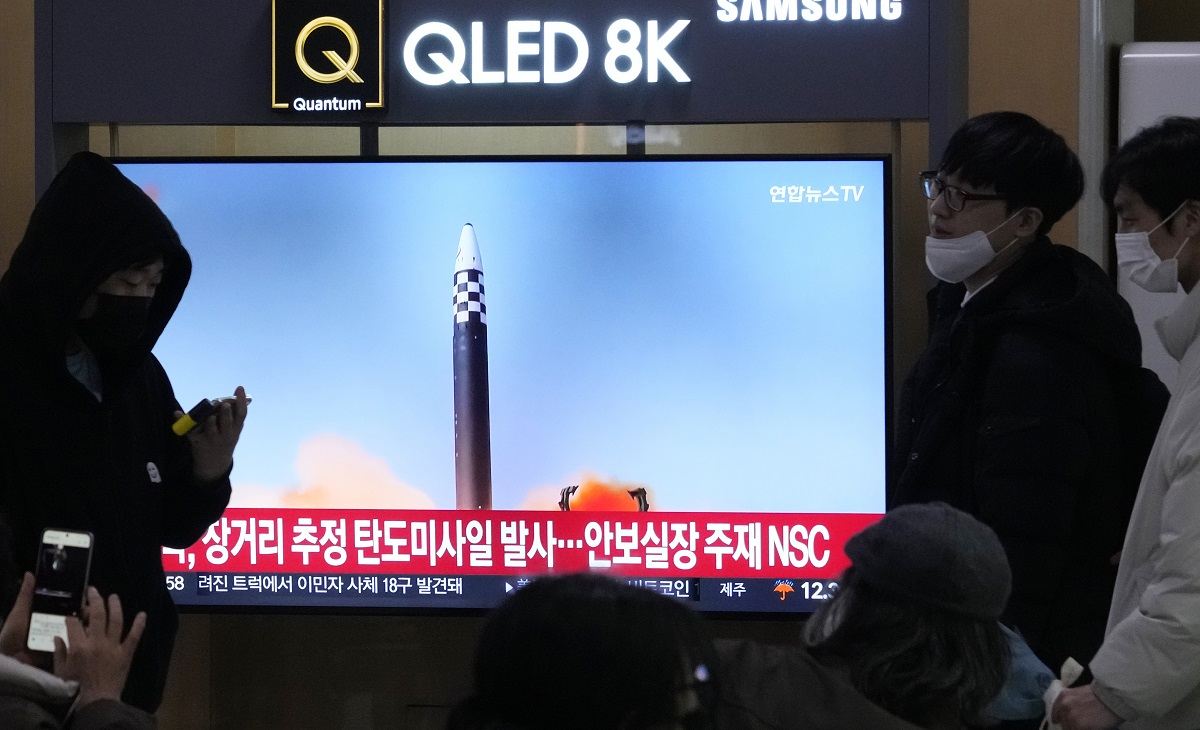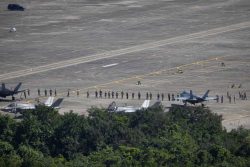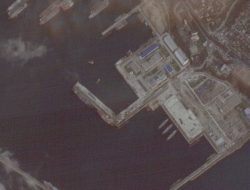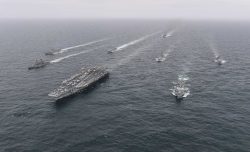
A TV screen shows a file image of North Korea’s missile launch during a news program at the Seoul Railway Station in Seoul on Saturday.
10:20 JST, February 19, 2023
SEOUL (Reuters) — North Korea said on Sunday it had tested a Hwasong-15 intercontinental ballistic missile (ICBM) the previous day in a “sudden launching drill” that confirmed its readiness for “mobile and mighty counterattack” against hostile forces.
North Korea launched a long-range ballistic missile into the sea off Japan’s west coast on Saturday afternoon after warning of a strong response to upcoming military drills by South Korea and the United States.
The surprise ICBM launching drill … is an actual proof of the DPRK strategic nuclear force’s consistent efforts to turn its capacity of fatal nuclear counterattack on the hostile forces into the irresistible one, the state news agency KCNA said. DPRK stands for North Korea’s official name, the Democratic People’s Republic of Korea.
In a separate statement on Sunday, North Korean leader Kim Jong Un’s sister, Kim Yo Jong, bristled at the United States for trying to turn the U.N. Security Council into what she called a “tool for its heinous hostile policy” toward Pyongyang.
I warn that we will watch every movement of the enemy and take corresponding and very powerful and overwhelming counteraction against its every move hostile to us, she said.
Saturday’s missile test, the North’s first missile firing since Jan. 1, came after Pyongyang threatened on Friday an “unprecedentedly persistent, strong” response as South Korea and the United States gear up for annual military exercises as part of efforts to fend off the North’s growing nuclear and missile threats.
The state news agency said the missile flew 989 km (614 miles) for 4,015 seconds, up to a maximum altitude of 5,768 km (3,584 miles) before accurately hitting a pre-set area in open waters. Hwasong-15 was first tested in 2017.
The launch, guided by the Missile General Bureau, was conducted on an “emergency firepower combat standby order” given at dawn, followed by a written order by Kim Jong Un, the KCNA said.
The flag of the missile bureau was first spotted in state media recently, suggesting the North may have created a military unit tasked with operating new ICBMs.
The important bit here is that the exercise was ordered day-of, without warning to the crew involved, said Ankit Panda, a missile expert at the United States–based Carnegie Endowment for International Peace. “The amount of time between the order and the launch is likely going to be decreased with additional testing.”
The military unit got an “excellent mark” over the test and the North’s ruling party “highly appreciated the actual war capacity of the ICBM units which are ready for mobile and mighty counterattack,” KCNA added.
Analysts say North Korea is likely to conduct more weapons tests, including a possible new solid-fuel missile, which could help the North deploy its missiles faster in the event of a war.
North Korea’s ballistic missile and nuclear weapons programs are banned under U.N. Security Council resolutions, but Pyongyang says its weapons development is necessary to counter “hostile policies” by Washington and its allies.
"News Services" POPULAR ARTICLE
-

American Playwright Jeremy O. Harris Arrested in Japan on Alleged Drug Smuggling
-

Japan’s Nikkei Stock Average as JGB Yields, Yen Rise on Rate-Hike Bets
-

Japan’s Nikkei Stock Average Licks Wounds after Selloff Sparked by BOJ Hike Bets (UPDATE 1)
-

Japan’s Nikkei Stock Average Buoyed by Stable Yen; SoftBank’s Slide Caps Gains (UPDATE 1)
-

Japanese Bond Yields Zoom, Stocks Slide as Rate Hike Looms
JN ACCESS RANKING
-

Keidanren Chairman Yoshinobu Tsutsui Visits Kashiwazaki-Kariwa Nuclear Power Plant; Inspects New Emergency Safety System
-

Imports of Rare Earths from China Facing Delays, May Be Caused by Deterioration of Japan-China Relations
-

University of Tokyo Professor Discusses Japanese Economic Security in Interview Ahead of Forum
-

Tokyo Economic Security Forum to Hold Inaugural Meeting Amid Tense Global Environment
-

Japan Pulls out of Vietnam Nuclear Project, Complicating Hanoi’s Power Plans


























